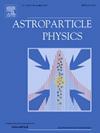基于似然的介子横向分布函数的组合积分器和二元检测器重建
IF 2.9
3区 物理与天体物理
Q1 ASTRONOMY & ASTROPHYSICS
引用次数: 0
摘要
能量E≥1018eV的超高能量宇宙射线的起源仍然未知。用于研究其性质的关键观测数据包括能谱,到达方向分布以及作为能量函数的组成。初级宇宙射线的组成是根据它们所引发的广泛的空气阵雨的特性,特别是根据对初级质量敏感的参数推断出来的。对主质量最敏感的参数是最大流星雨的大气深度,通常用荧光望远镜测量,以及流星雨的介子含量,用专用的介子探测器测量。在成分研究中,一个常用的观测值是在距离淋浴轴一定距离处的μ子密度,它是通过在参考距离处评估重建的μ子横向分布函数(MLDF)得到的。特定类型的μ子检测器具有两种采集模式:二进制和积分器(通常称为ADC模式,用于模数转换器)。二进制模式允许直接μ子计数,而ADC模式从检测器响应的集成信号推断μ子数。现有的方法要么单独使用采集模式的数据,要么将两者结合起来重建MLDF,但通常在给定事件中为每个监测站分配单一模式。本文提出了一种基于似然方法重建MLDF的新方法,该方法同时结合了每个检测站两种采集模式的数据。本文以皮埃尔·奥格天文台的地下介子探测器为例进行了研究。然而,这种通用方法可以应用于未来具有双采集能力的检测器。我们的结果表明,组合方法优于仅依赖二进制或ADC模式数据的传统技术。本文章由计算机程序翻译,如有差异,请以英文原文为准。
Likelihood-based reconstruction of muon lateral distribution function using combined integrator and binary detector modes
The origin of ultra-high-energy cosmic rays, with energies , remains unknown. Among the key observables used to investigate their nature are the energy spectrum, the arrival direction distribution, and the composition as a function of energy. The composition of the primary cosmic ray is inferred from properties of the extensive air showers they initiate, particularly from parameters sensitive to the primary mass. The most sensitive parameters to the primary mass are the atmospheric depth of the shower maximum, typically measured with fluorescence telescopes, and the muon content of the shower, measured using dedicated muon detectors. A commonly used observable in composition studies is the muon density at a fixed distance from the shower axis, derived by evaluating the reconstructed muon lateral distribution function (MLDF) at a reference distance. A specific type of muon detector features two acquisition modes: binary and integrator (commonly referred to as ADC mode, for Analog-to-Digital Converter). The binary mode allows for direct muon counting, while the ADC mode infers the muon number from the integrated signal of the detector response. Existing methods reconstruct the MLDF using data from either acquisition mode individually, or by combining both, but usually assigning a single mode per detector station in a given event. This work presents a novel method to reconstruct the MLDF based on a likelihood approach that simultaneously incorporates data from both acquisition modes at each detector station. We apply our method to the underground muon detectors of the Pierre Auger Observatory as a case study. However, this general approach can be applied to future detectors with dual acquisition capabilities. Our results demonstrate that the combined method outperforms traditional techniques that rely solely on either binary or ADC mode data.
求助全文
通过发布文献求助,成功后即可免费获取论文全文。
去求助
来源期刊

Astroparticle Physics
地学天文-天文与天体物理
CiteScore
8.00
自引率
2.90%
发文量
41
审稿时长
79 days
期刊介绍:
Astroparticle Physics publishes experimental and theoretical research papers in the interacting fields of Cosmic Ray Physics, Astronomy and Astrophysics, Cosmology and Particle Physics focusing on new developments in the following areas: High-energy cosmic-ray physics and astrophysics; Particle cosmology; Particle astrophysics; Related astrophysics: supernova, AGN, cosmic abundances, dark matter etc.; Gravitational waves; High-energy, VHE and UHE gamma-ray astronomy; High- and low-energy neutrino astronomy; Instrumentation and detector developments related to the above-mentioned fields.
 求助内容:
求助内容: 应助结果提醒方式:
应助结果提醒方式:


